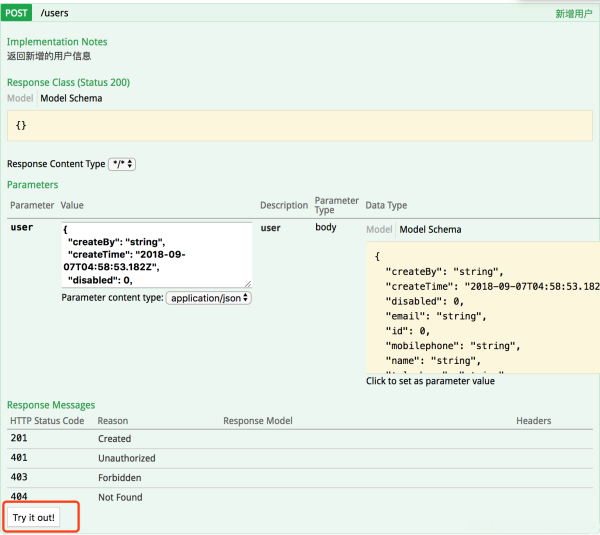今天小编就为大家分享一篇关于SpringBoot+Swagger-ui自动生成API文档,小编觉得内容挺不错的,现在分享给大家,具有很好的参考价值,需要的朋友一起跟随小编来看看吧
随着互联网技术的发展,现在的网站架构基本都由原来的后端渲染,变成了:前端渲染、先后端分离的形态,而且前端技术和后端技术在各自的道路上越走越远。
这样后段开发好了api 之后就要提交api 文档给前端的朋友。给前端的api 文档各个公司有各个公司的要求,有的是word 有的是 md 文档,或者是 postman 的一个连接。
好了废话不多说说一下 swagger -ui 吧
什么是Swagger
Swagger是一个Restful风格接口的文档在线自动生成和测试的框架
官方描述:The World's Most Popular Framework for APIs.
先看一下 swagger-ui 生成的api 的效果吧(这是一个增删改查的小李子)

然后我们打开查询所有用户的api 看到api 内容

然后在服务器运行的状态下点击 try it out 测试查询功能

接着打开新增的api 查看

好了这个就是自动生成的api 效果。接下来我们就看怎么在我们的项目中使用swagger-ui 吧
springboot 集成 swagger -ui
1、添加依赖
io.springfox springfox-swagger2 2.2.2 io.springfox springfox-swagger-ui 2.2.2
2、编写配置文件
在application 同级目录新建 Swagger2 文件
package com.abel.example; import org.springframework.context.annotation.Bean; import org.springframework.context.annotation.Configuration; import springfox.documentation.builders.ApiInfoBuilder; import springfox.documentation.builders.PathSelectors; import springfox.documentation.builders.RequestHandlerSelectors; import springfox.documentation.service.ApiInfo; import springfox.documentation.spi.DocumentationType; import springfox.documentation.spring.web.plugins.Docket; import springfox.documentation.swagger2.annotations.EnableSwagger2; /** * Created by yangyibo on 2018/9/7. */ @Configuration @EnableSwagger2 public class Swagger2 { /** * 创建API应用 * apiInfo() 增加API相关信息 * 通过select()函数返回一个ApiSelectorBuilder实例,用来控制哪些接口暴露给Swagger来展现, * 本例采用指定扫描的包路径来定义指定要建立API的目录。 * @return */ @Bean public Docket createRestApi() { return new Docket(DocumentationType.SWAGGER_2) .apiInfo(apiInfo()) .select() .apis(RequestHandlerSelectors.basePackage("com.abel.example.controller")) .paths(PathSelectors.any()) .build(); } /** * 创建该API的基本信息(这些基本信息会展现在文档页面中) * 访问地址:http://项目实际地址/swagger-ui.html * @return */ private ApiInfo apiInfo() { return new ApiInfoBuilder() .title("Spring Boot中使用Swagger2构建RESTful APIs") .description("更多请关注https://blog.csdn.net/u012373815") .termsOfServiceUrl("https://blog.csdn.net/u012373815") .contact("abel") .version("1.0") .build(); } }3、在controller上添加注解,自动生成API
注意:
package com.abel.example.controller; import javax.servlet.http.HttpServletRequest; import java.util.Map; import com.abel.example.bean.User; import io.swagger.annotations.*; import org.apache.log4j.Logger; import org.springframework.beans.factory.annotation.Autowired; import org.springframework.http.HttpStatus; import org.springframework.http.ResponseEntity; import org.springframework.stereotype.Controller; import org.springframework.web.bind.annotation.*; import com.abel.example.service.UserService; import com.abel.example.util.CommonUtil; @Controller @RequestMapping(value = "/users") @Api(value = "用户的增删改查") public class UserController { @Autowired private UserService userService; /** * 查询所有的用户 * api :localhost:8099/users * @return */ @RequestMapping(method = RequestMethod.GET) @ResponseBody @ApiOperation(value = "获取用户列表,目前没有分页") public ResponseEntity注解含义:
@Api:用在类上,说明该类的作用。 @ApiOperation:注解来给API增加方法说明。 @ApiImplicitParams : 用在方法上包含一组参数说明。 @ApiImplicitParam:用来注解来给方法入参增加说明。 @ApiResponses:用于表示一组响应 @ApiResponse:用在@ApiResponses中,一般用于表达一个错误的响应信息 code:数字,例如400 message:信息,例如"请求参数没填好" response:抛出异常的类 @ApiModel:描述一个Model的信息(一般用在请求参数无法使用@ApiImplicitParam注解进行描述的时候) @ApiModelProperty:描述一个model的属性
注意:@ApiImplicitParam的参数说明:

paramType会直接影响程序的运行期,如果paramType与方法参数获取使用的注解不一致,会直接影响到参数的接收。
4、启动项目效果图:
服务器启动后访问 http://localhost:8099/swagger-ui.html 效果如下

点击查看效果

本文项目全部代码:https://github.com/527515025/springBoot/tree/master/springboot-swagger-ui
总结
以上就是这篇文章的全部内容了,希望本文的内容对大家的学习或者工作具有一定的参考学习价值,谢谢大家对html中文网的支持。如果你想了解更多相关内容请查看下面相关链接
以上就是SpringBoot+Swagger-ui自动生成API文档的详细内容,更多请关注0133技术站其它相关文章!







